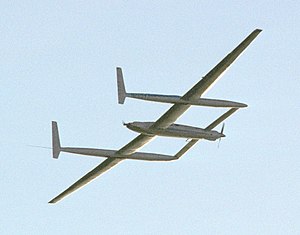Rutan Voyager
| Rutan Voyager | |
|---|---|
 Voyager after circumnavigating the world Voyager after circumnavigating the world
|
|
| Type: | Ultra long range aircraft |
| Design country: | |
| Manufacturer: | |
| First flight: |
June 22, 1984 |
| Number of pieces: |
1 |
The Voyager (registration number N269VA) is a record-breaking aircraft developed by Burt Rutan that is designed for extreme range. With him the first circumnavigation of the world in the air without refueling. The aircraft was built in Mojave , California within five years. The first flight took place on June 22, 1984. The machine is on display today at the National Air and Space Museum in Washington, DC . The model is currently hanging in the departure lounge at Seattle International Airport
construction
The twin-engined mid - decker in canard design is designed for two pilots who can take turns during the flight. Both engines were working at the beginning of the flight. When the amount of fuel decreased and the aircraft weight decreased, the front engine was then to be switched off.
The aircraft is mainly made of CFRP with a core made of Hexcel HexWeb Honeycomb, a sandwich structure with a honeycomb core . With this construction, almost every part of the aircraft was designed as a fuel tank. For weight reasons, the chassis only has a manual operation. For navigation, the aircraft was equipped with an Omega navigation device and a Global Positioning System receiver. However, because the satellites had not yet started, this could only be used for about four hours a day. In addition, a weather radar was installed in the nose of the right boom.
Record flight
The brother of the designer, Dick Rutan and Jeana Yeager took off on December 14, 1986 at 08:01 local time in the Edwards Air Force Base with this airplane to the first nonstop - world flight without refueling and intermediate landing. They flew a distance of 42,120 kilometers in nine days, three minutes and 44 seconds, with the FAI only recognizing 40,212 kilometers of the route. After the record flight was over, only 32 liters of fuel remained in the main tank.
Problems circumnavigating the world
Due to errors (nose gear set too low, main landing gear inflated too much), the wing tips were pressed onto the runway and damaged during take-off to circumnavigate the world. The winglets , which were also damaged , were sheared off in a controlled manner by means of a sideslip in the first hours of the record flight . Due to the large extension of the wings, this did not result in a critical shortening of the range, but it did lead to a loss of fuel. There were also some incidents, such as B. defective course top, foam formation in - then still new - overheated synthetic oil . The currently running engine stopped due to an empty tank that was not recognized when the fuel was pumped into the main tank. A fuel pump had to be replaced during the flight.
Technical specifications
| Parameter | Data |
|---|---|
| crew | 2 |
| length | 8.9 m |
| Wingspan with winglets | 33.8 m |
| height | 3.1 m |
| Empty mass | 1020 kg |
| Max. Takeoff mass | 4400 kg |
| Max. Fuel mass | 3180 kg distributed over 17 fuel tanks |
| Top speed | 240 km / h |
| Cruising speed | 185 km / h |
| maximum altitude | 6250 m |
| Range | 42,212 km |
| Engines |
|
Source see .
See also
- Virgin Atlantic GlobalFlyer - the second aircraft to make a non-stop circumnavigation of the world without refueling
- List of aircraft types
Web links
- Christoph Gunkel: Crazy record attempt: Ride on the gasoline bomb at Spiegel Online from December 22, 2011.
Individual evidence
- ↑ Dick Rutan, Jeana Yeager, and the Flight of the Voyager. US Centennial of Flight Commission, archived from the original on October 2, 2012 ; accessed on September 15, 2017 (English).
- ↑ Official FAI record database . Archived from the original on October 7, 2007. Retrieved September 5, 2007.
- ^ Jeana Yeager / Dick Rutan: Voyager - non-stop around the world in nine days , October 1991, R. Piper, Munich, ISBN 3-492-11435-0 .
- ^ Rutan Voyager - Summary. Smithsonian National Air and Space Museum, accessed January 6, 2012 .